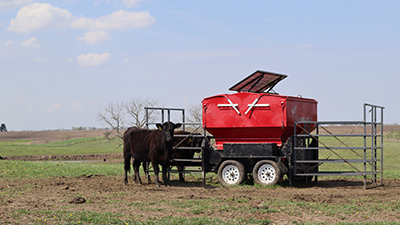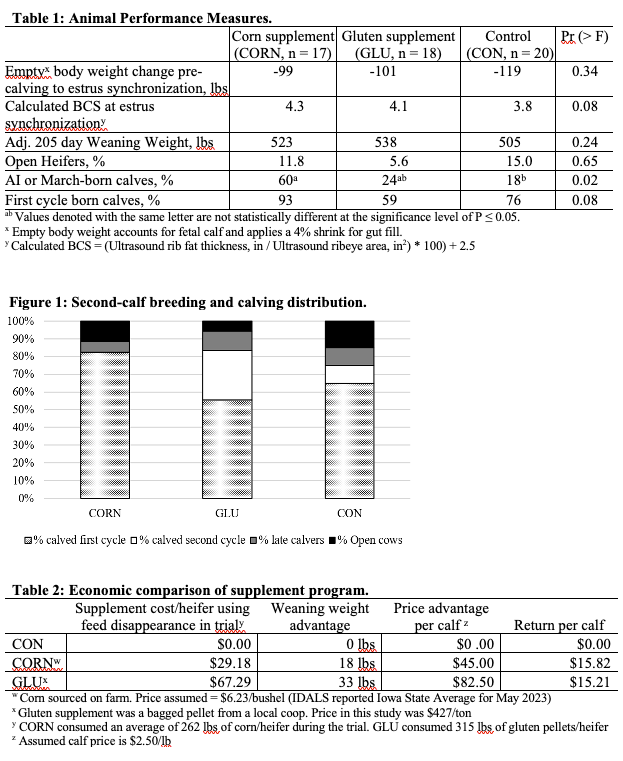Growing Beef Newsletter
July 2024, Volume 15, Issue 1

Starch and digestible fiber-based supplementation impact on first calf heifer performance and nutrient mobilization through the production cycle
Beth Reynolds
A widely accepted challenge for cow-calf producers is getting first calf heifers to rebreed amid the high nutritional demands of recovering postpartum, lactating, and continuing to grow themselves. Often, supplementation is warranted simply because the nutrient requirements are greater than what most forages can provide in early spring.
A study at the ISU McNay Research Farm in south central Iowa observed 2-year-old heifers from their first parturition over the course of a production year. From calving through four weeks post-AI, heifers were allocated to one of three treatment groups: an unsupplemented control, a corn supplement group (CORN), or a gluten supplement group (GLU). Supplements were delivered through a Super SmartFeed™ feeder, from C-Lock Inc., which utilizes EID tags to provide a set amount of supplement to individual animals. For approximately one month following calving when hay made up the bulk of the diet, supplement levels (5.56 lbs for CORN and 6.12 lbs for GLU) were determined based on hay analysis. When pasture became the primary forage source and hay feeding ceased, supplement levels were reduced (2.38 lbs for CORN and 2.95 lbs for GLU) Supplementation ended approximately four weeks following artificial insemination. Multiple variables were measured to compare heifer and calf performance between groups over the course of a production year.
The high nutritional demands of peak lactation caused females to lose weight and condition between calving and breeding season as expected. Heifer numbers utilized in the study limited the statistical differences observed (Table 1), but when observing numeric differences, unsupplemented heifers had the poorest condition at the time of synchronization. Supplementing first calf heifers improved conception to artificial insemination and the number of open heifers after the 65-day breeding season (Figure 1). Likewise, supplementation treatments averaged a 25-pound 205-day adjusted weaning weight advantage compared to calves nursing unsupplemented dams. In addition to heifer and calf performance measures, cool season, unimproved fescue-based pasture samples were taken weekly during the supplementation period and analyzed post-study for yield and quality. The results showed that pasture quality was below expectations and drought significantly restricted quantity.
Applying some simple math in Table 2 can help evaluate the supplement return on investment. To limit our example to just the corn-supplemented group, the weaning weight advantage was 18 lbs/calf. If we assume a calf price of $2.50/lb, that’s about a $45 added value. On average, each heifer in the corn group consumed just shy of 5 bu of corn per heifer. At $6.23/bu, corn was $31/heifer for the supplementation period. In this scenario, the economics dictated that supplementation of first calf heifers from calving to breeding was economical, even without considering the next calf crop’s advantage from CORN realizing fewer open heifers and more calves sired AI.

*This research was funded by the Iowa State Beef Checkoff. Iowa State University Extension and Outreach personnel involved in the project are Randie Culbertson, Garland Dahlke, Erika Lundy-Woolfolk, Beth Reynolds, and Patrick Wall.
This monthly newsletter is free and provides timely information on topics that matter most to Iowa beef producers. You’re welcome to use information and articles from the newsletter - simply credit Iowa Beef Center.
